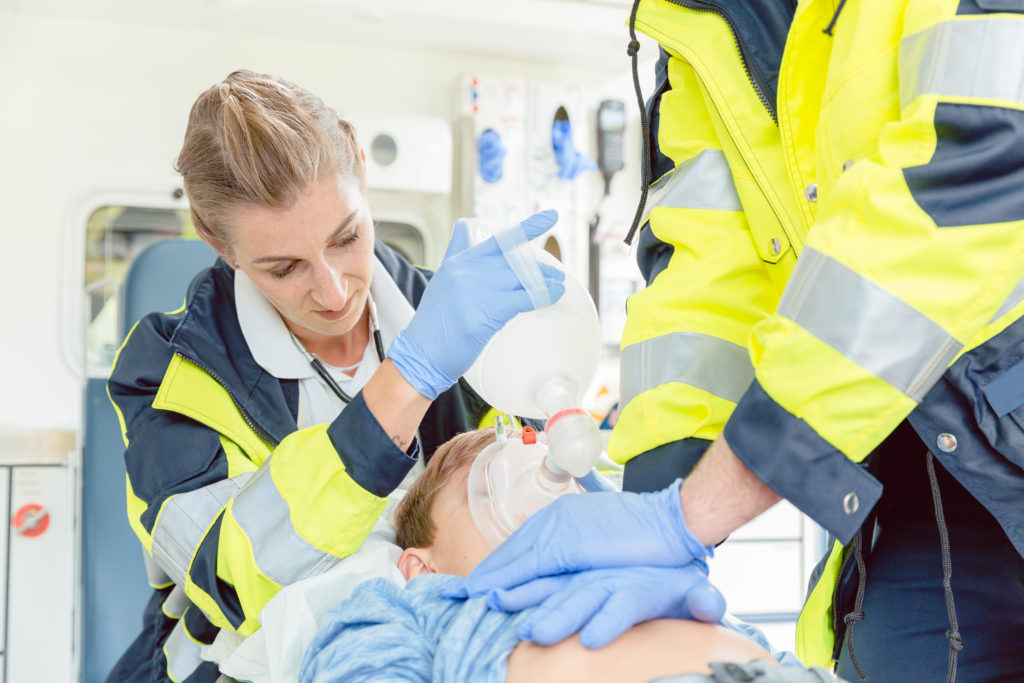
Get CPR training for your team!
If you have any questions feel free to email us at info@emccprtraining.com
CONTACT ONE OF OUR EXPERTS HERE

Last Updated on April 30, 2023 by CPR Training
Some people, such as men over the age of 40, are at greater risk of sudden cardiac arrest (SCA), but SCA can affect anyone, even children. Common causes of SCA among children include Sudden Infant Death Syndrome, trauma, accidents, and congenital heart disease.
After undergoing SCA, both infants and children have a much better chance of survival if they receive CPR immediately. However, CPR is only one of the links in what is known as the Chain of Survival.
The Chain of Survival describes a rapid sequence of events that must occur when someone undergoes SCA to increase his chances of survival. For adults, the chain of survival goes as follows:
Immediate treatment is essential to the survival of an SCA victim, and following the Chain of Survival increases the chance that a victim will receive the treatment and attention he needs. If any links in the Chain of Survival are weak or missing, a victim is less likely to survive. Bear in mind that you only have a matter of minutes to restart the heart.
The Pediatric Chain of Survival goes as follows:
The first link in the Pediatric Chain of Survival is the prevention of injuries, accidents, and trauma that could lead to cardiac arrest. Prevention is particularly important in the Pediatric Chain of Survival because unintentional injuries are the number one killer of children in America. By preventing these injuries from occurring in the first place, we can save more children’s lives. Learning child CPR and First Aid is not sufficient; preventing emergencies from occurring on a daily basis through childproofing your home and other means is critical.
Furthermore, in infants and children, the cause of circulatory failure is generally respiratory failure. So, if a rescuer is alone with an unresponsive child or infant, he should perform around two minutes of CPR (5 cycles) to deliver some oxygen before calling 911. CPR is most effective when it’s performed immediately after the victim’s collapse.
Remember: the Chain of Survival is only as strong as its weakest link. If you want to respond quickly and effectively in a pediatric emergency, undergo training in Pediatric First Aid and CPR regularly and memorize the Pediatric Chain of Survival. By following the links of the Pediatric Chain of Survival, you could prevent serious injuries or even save a child’s life.
ABOUT EMC CPR & SAFETY TRAINING, A PREMIER CPR TRAINING COMPANY BASED OUT OF NEW YORK CITY:
EMC CPR & Safety Training, LLC is a company who specializes in providing American Heart Association courses and certification. Our team of instructors has trained thousands of students on the nationwide. We offer free phone consultation to determine how we can best meet your course needs; phone 800.695.5655 today to learn how we can help you save a life.
Disclaimer
All the information on this website – www.emccprtraining.com – is published in good faith and for general information purposes only. EMC CPR & Safety Training, LLC does not make any warranties about the completeness, reliability, and accuracy of this information. Any action you take upon the information you find on this website (EMC CPR & Safety Training, LLC), is strictly at your own risk. EMC CPR & Safety Training, LLC will not be liable for any losses and/or damages in connection with the use of our website.
From our website, you can visit other websites by following hyperlinks to such external sites. While we strive to provide only quality links to useful and ethical websites, we have no control over the content and nature of these sites. These links to other websites do not imply a recommendation for all the content found on these sites. Site owners and content may change without notice and may occur before we have the opportunity to remove a link which may have gone ‘bad’.
Please be also aware that when you leave our website, other sites may have different privacy policies and terms which are beyond our control. Please be sure to check the Privacy Policies of these sites as well as their “Terms of Service” before engaging in any business or uploading any information
By using our website, you hereby consent to our disclaimer and agree to its terms.
Get CPR training for your team!
If you have any questions feel free to email us at info@emccprtraining.com
CONTACT ONE OF OUR EXPERTS HERE